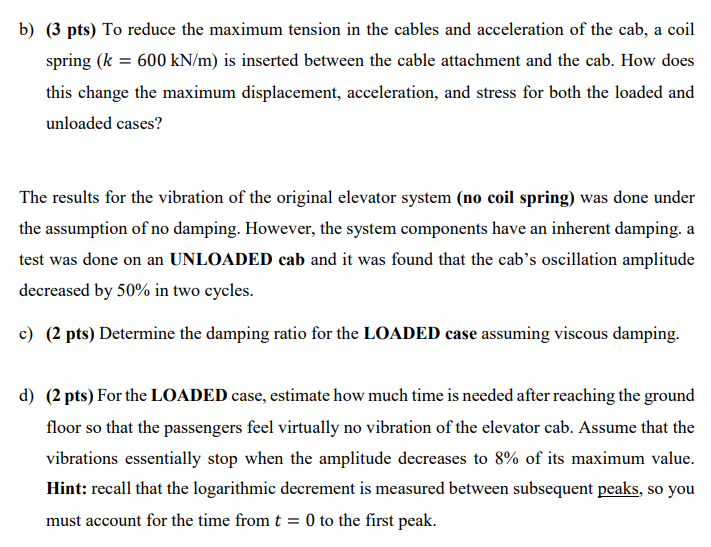Answered step by step
Verified Expert Solution
Question
1 Approved Answer
The figure shows a traction elevator system used in high-rise residential buildings. These traction elevators consist of hoist cables connected to the top of


The figure shows a traction elevator system used in high-rise residential buildings. These traction elevators consist of hoist cables connected to the top of the cab operated by a traction machine (electric motor) located in the penthouse. The system is modelled as a simple spring-mass system, where the spring represents the cable stiffness and the mass corresponds to the elevator cab and its occupants (counterweights are neglected). MACHINE ROOM LANDING LANDING LANDING LANDING CAR GUID RAIL OVER RIDE COUNTER WEIGHT Traction System Elevator Cab ww m L X Penthouse Basement Floor The elevator provides a rapid ascent/descent, while not causing excessive acceleration to the passengers or stress in the cable system. The situation under consideration is the stop after descent to the basement floor level for a 10-story apartment building (assume 3.5 m per story). Assume that the traction motor stops instantly when reaching the basement floor (acts as a fixed support). The velocity of the cab before stopping is 1.5 m/s. The cables have an equivalent stiffness of a single cable with a radius of 2 cm and an elastic modulus of 100 GPa (k = EA). a) Consider both cases with an unloaded cab (mass of 1.2 metric tonnes) and with a maximum capacity of 15 people with an average weight of 70 kg each. For each case, determine: i. (1 pt) The overshoot of the cab past the basement floor level after stopping. ii. (1 pt) The maximum acceleration felt by the occupants. iii. (1 pt) The maximum stress in the cables. b) (3 pts) To reduce the maximum tension in the cables and acceleration of the cab, a coil spring (k = 600 kN/m) is inserted between the cable attachment and the cab. How does this change the maximum displacement, acceleration, and stress for both the loaded and unloaded cases? The results for the vibration of the original elevator system (no coil spring) was done under the assumption of no damping. However, the system components have an inherent damping. a test was done on an UNLOADED cab and it was found that the cab's oscillation amplitude decreased by 50% in two cycles. c) (2 pts) Determine the damping ratio for the LOADED case assuming viscous damping. d) (2 pts) For the LOADED case, estimate how much time is needed after reaching the ground floor so that the passengers feel virtually no vibration of the elevator cab. Assume that the vibrations essentially stop when the amplitude decreases to 8% of its maximum value. Hint: recall that the logarithmic decrement is measured between subsequent peaks, so you must account for the time from t = 0 to the first peak.
Step by Step Solution
★★★★★
3.43 Rating (150 Votes )
There are 3 Steps involved in it
Step: 1
To determine the number of teeth on all the wheels and the exact pitch circle diameter of A we can f...
Get Instant Access to Expert-Tailored Solutions
See step-by-step solutions with expert insights and AI powered tools for academic success
Step: 2

Step: 3

Ace Your Homework with AI
Get the answers you need in no time with our AI-driven, step-by-step assistance
Get Started


